PRODIGY TO PROGENY:
BEETHOVEN AS PUPIL, TEACHER, AND PARADIGM
This exhibit draws on the collections of the Ira F. Brilliant Center for Beethoven Studies to trace Beethoven’s path as student, teacher, and paradigm. The physical exhibit took place at the Beethoven Center from February 1 – September 30, 2011. Patricia Stroh, Curator
INTRODUCTION
BEETHOVEN started his musical life being groomed as a performer. Promoting Ludwig as a prodigy, his father organized his first public concert at the age of seven. Although Beethoven studied violin, organ, and other keyboard instruments, it was his phenomenal skill on the fortepiano that later gained his entry to the palaces and patronage of the Viennese aristocracy. While he endeavored to establish himself as a composer, he was sought out as a fortepiano teacher, especially by the families of young women of the noble class. Through his teaching of his most tireless student, Carl Czerny, Beethoven passed down a legacy of ideas about interpreting his own piano works, particularly the sonatas. For succeeding generations of concert pianists, the ability to perform the entire cycle of Beethoven’s 32 sonatas for piano has become the pinnacle of achievement.
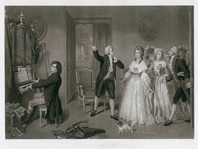
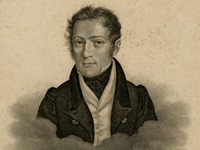
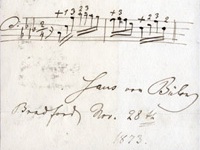
THE PRODIGY
A CHILD MUSICIAN
We do not know exactly when Beethoven started his musical training, but by the age of six his instruction had progressed rapidly under the strict guidance of his father Johann, who made his living as a court singer and private music tutor. At that time the Beethoven family lived with the Fischer family Bonn. Several decades later, in 1838, Cäcilia Fischer (1762-1845) and her brother Gottfried (1780-1864) began writing down their reminiscences of Beethoven as a child. The Fischer manuscript and the Biographische Notizen by Franz Gerhard Wegeler and Ferdinand Ries are the sources for many of the stories of Beethoven’s childhood, some of which cannot be confirmed. However, Cäcilia Fischer, Wegeler, and other observers recounted seeing little Ludwig practicing for long hours, sometimes standing on a footstool in front of the keyboard instrument. [Thayer/Forbes p. 57; see also Solomon p. 22 who cites several other sources]. Despite the severity of his early training, Beethoven’s natural talent and inclination for music shined through the drudgery. By the age of seven he was performing in public on the “clavier,” a word used to describe either the clavichord, harpsichord, or fortepiano.
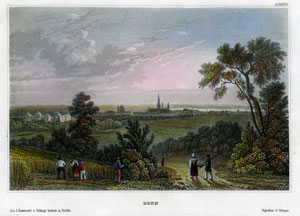
Bonn, Germany, Beethoven’s Birthplace Steel engraving published by the Bibliographisches Institut in Hilburghausen, ca. 1850 – Gift of the American Beethoven Society, 2008
The modern nation of Germany did not exist during Beethoven’s time. On this map, the cartographer drew “Germany” as the individual states of the Kingdom of Prussia as well as parts of the bordering countries, including the Austrian Empire. Beethoven’s hometown, Bonn, is situated in the beautiful valley along the Rhine River. According to the Fischer reminiscences, as a youth Beethoven embarked on excursions outside of Bonn with his family and their friends, visiting several of the beautiful regions along the Rhine [Thayer/Forbes p. 62-63]. In 1783, during a trip with his mother to Holland to visit relatives, Ludwig’s musical prowess attracted considerable attention (but few “gifts,” to the family’s disappointment) [Thayer/Forbes p. 63, again from Fischer manuscript]. Beethoven would not leave Bonn again until 1787, when he made the long trip to Vienna, stopping at Munich, Augsburg, and other villages along the way.
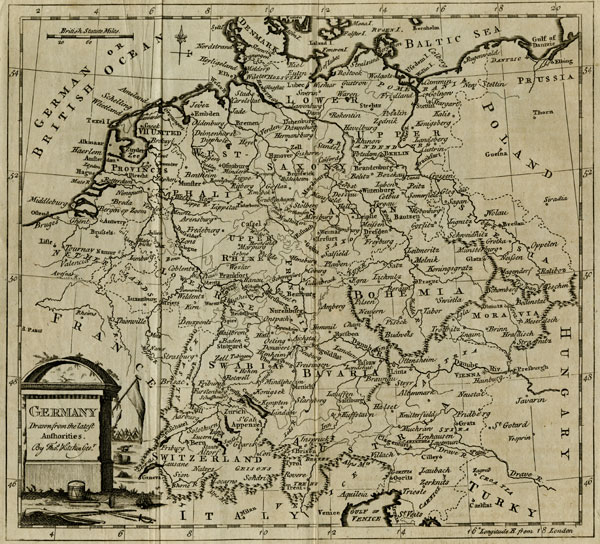
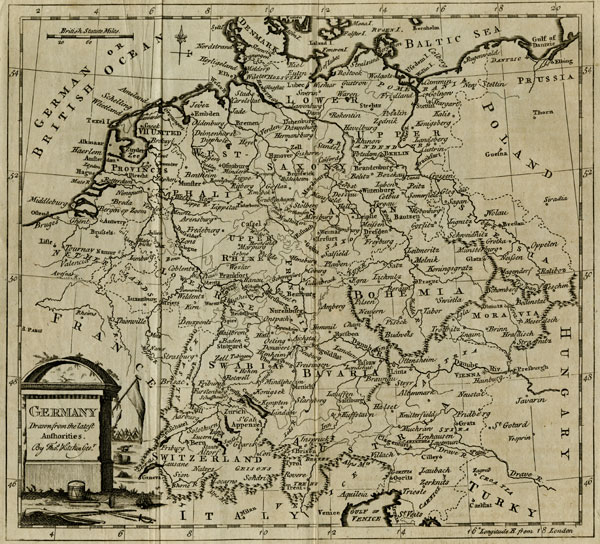
MAP OF GERMANY IN 1785 Drawn “from the latest authorities” by geographer Thomas Kitchin and printed in London. The blue dots show the location of Bonn and Vienna. Gift of the American Beethoven Society, 2004
Beethoven’s duties as a court musician were considerable. He played organ at the court and assisted Neefe at the Minorite Church. During Neefe’s extended absense, Beethoven also served as the rehearsal fortepianist at the theater and sometimes played viola in the orchestra. He did find some time to exercise his creative energy by composing music. By the age of twelve he had composed a set of variations and three sonatas for fortepiano. With these compositions, Beethoven transferred his skill on the keyboard to the printed page. He also composed two small pieces published in the collection, Blumenlese für Klavierliebhaber (Anthology for Keyboard Lovers) intended for the amateur musician. One was Beethoven’s Rondo in C Major, WoO 48. The other was the song “Schilderung eines Mädchen” (“Description of a Maiden”), Beethoven’s first work for voice and fortepiano. Here is a translation of the anonymous poem:
Do you want me, my friend, to describe Elise to you?
May Uz’s spirit inspire me!
Just as stars glitter on a winter’s night,
So would Oeser paint the splendor of her eyes.
A young woman nicknamed “Elise” would later become a figure in Beethoven’s life as a teacher. “Uz” may refer to the great-grandson of Noah or to the place where Job lived. The name Oeser likely refers to Adam Friendrich Oeser (1717-1799), a German etcher, painter, and sculptor who was Goethe’s drawing teacher.

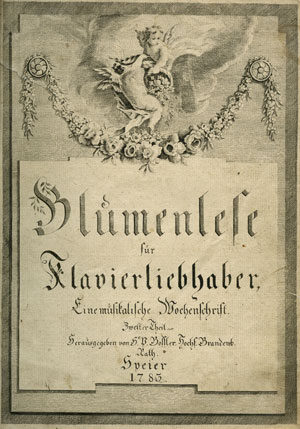
“Schilderung eines Mädchen,” WoO 107 First edition of Beethoven’s song composed when he was twelve and published in the collection Blumenlese für Klavierliebhaber by Bossler in Speyer in 1783. The collection also contains Beethoven’s Rondo in C Major, WoO 48. Gift of the American Beethoven Society, 2004
KEYBOARD STUDIES
The first published notice of Beethoven, written by his teacher Neefe, appeared in this music magazine when Beethoven was twelve (not eleven, as stated there):
“Louis van Betthoven, son of the above-mentioned tenor, a boy of eleven years [sic] and of very promising talent. He plays the keyboard skillfully and powerfully, sight-reads very well, and to sum it up, he mostly plays The Well-Tempered Clavier of Sebastian Bach, which Mr. Neefe has placed in his hands. Whoever knows this collection of preludes and fugues in all keys (which one could call the non plus ultra) will know what that means. Insofar as his other duties allow, Mr. Neefe has also given him some instruction in the thoroughbass. Now he is training him in composition, and to give him encouragement has had his variations on a march for keyboard engraved in Mannheim. This young genius deserves the support to enable him to travel. He would certainly become a second Wolfgang Amadeus Mozart if he were to continue to progress as he has begun.” (Translation by Wayne Senner)
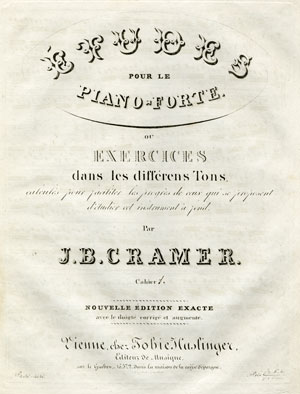
Fortepiano Studies by Johann Baptist Cramer
Cramer originally published his fortepiano studies in 1804. This new, revised edition was published by Tobias Haslinger in Vienna in 1821. Gift of the American Beethoven Society, 1994
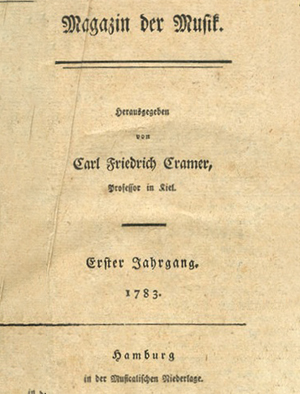
KEYBOARD STUDIES C.F. Cramer’s Magazin der Musik, first half of 1783, published by the Musikalische Niederlage in Hamburg. Gift of the American Beethoven Society, 2002
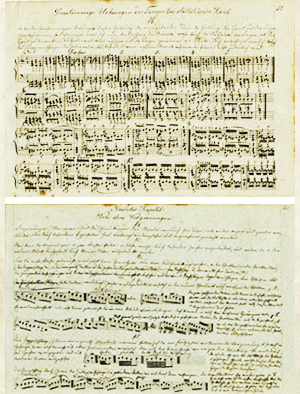
A Keyboard Method Book from 1790-1800; Two pages from a manuscript by an unidentified teacher; Gift of the American Beethoven Society, 2009 and 2010
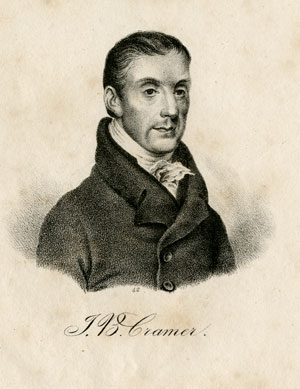
Fortepiano Studies by Johann Baptist Cramer
Cramer originally published his fortepiano studies in 1804. This new, revised edition was published by Tobias Haslinger in Vienna in 1821. Gift of the American Beethoven Society, 1994
The exercises in this manuscript are typical of the keyboard passagework in which Beethoven excelled. The page on the left contains “Three-voice exercises of the fingers with motionless hand” (with exercises for the hand in up and down motion on the reverse). Beethoven developed a connected (“legato”) style for which he became especially renowned. One observer remarked in 1803 that he “played with his hands so very still; wonderful as his execution was, there was not tossing of them to and fro, up and down; they seemed to glide right and left over the keys, the fingers alone doing the work.” Beethoven was also a master of the trill, with the ability to play simultaneous trills in two hands and double trills. The manuscript page on the right gives instruction and examples for realization of ornaments such as trills and turns.
We do not know if Beethoven’s teachers used method books for his lessons, but it is clear that he developed some of his skill on the keyboard by playing the music of J.S. Bach. Later, as a teacher, Beethoven also preferred the Klavierschule of Muzio Clementi and the studies by his friend Johann Baptist Cramer, whose fortepiano playing Beethoven much admired. Beethoven’s copy of the Cramer Studies is preserved today in the Berlin Library.
BEETHOVEN’S TEACHERS IN VIENNA
In Bonn Beethoven met Joseph Haydn and showed him the manuscript for his latest composition, a funeral cantata for Joseph II. Haydn was sufficiently impressed and encouraged Beethoven to continue his studies in Vienna. But after Beethoven’s arrival there in 1792, he worked not only with Haydn but with several other teachers, including Johann Baptist Schenk, Emanuel Aloys Förster, Anton Salieri, and Johann Georg Albrechtsberger.
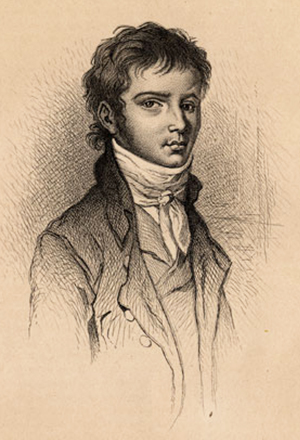
Beethoven at around age 30
Portrait lithograph by Masson, Deblois and Massard based on the engraving by Joseph Neidl from 1801, published in the book Les musiciens célèbres depuis le seizième siècle jusqu’à nos jours by Félix Clèment, first published in 1868.
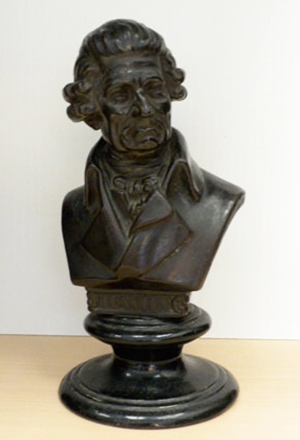
Joseph Haydn (1732-1809)
Clay bust by Rudolf Uffrecht, 1863. Gift of the American Beethoven Society, 2003
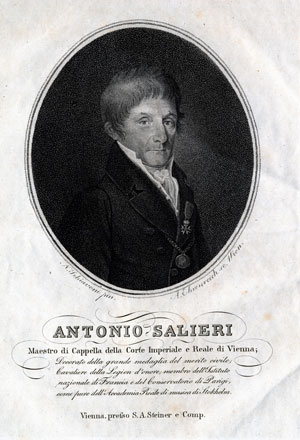
Antonio Salieri (1750-1825)
Portrait engraving by A. Ehrenreich based on a painting by Natale Schiavoni, published in Vienna by S.A. Steiner & Comp. and printed as a frontispiece for volume 3 of the Allgemeine musikalische Zeitung,1819. Gift of the American Beethoven Society, 2004
Some of you may recognize Salieri’s name from the play (and movie) Amadeus, in which he is the bitter rival of Mozart and instrument of Mozart’s untimely death. In truth, Salieri was a prominent and respected court musician, teacher, and composer of numerous operas. Beethoven turned to him for instruction in vocal composition. Salieri was also a leader of the Tonkünstler-Society and conducted the orchestra for Beethoven’s first public appearance in Vienna, in which Beethoven performed as a soloist for one of his own concertos. Beethoven expressed his respect for Salieri by dedicated his first three Sonatas for Violin and Fortepiano, Opus 12, to this teacher.
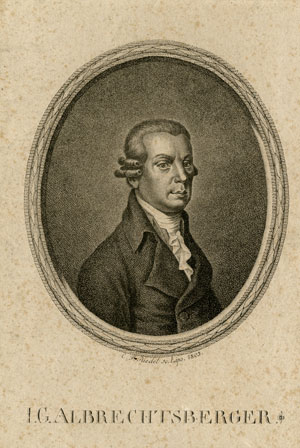
J.G. Albrechtsberger’s sämmtliche Schriften über Generalbass, Harmonie-Lehre, und Tonsetzkunst(J.G. Albrechtsberger’s Collected Writings on Thoroughbass, Harmony, and Composition), published in 3 volumes in Vienna by Anton Strauss, 1826. Gift of the American Beethoven Society
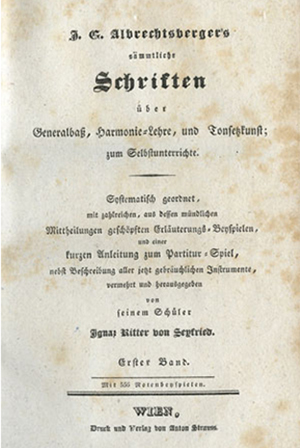
J.G. Albrechtsberger’s sämmtliche Schriften über Generalbass, Harmonie-Lehre, und Tonsetzkunst(J.G. Albrechtsberger’s Collected Writings on Thoroughbass, Harmony, and Composition), published in 3 volumes in Vienna by Anton Strauss, 1826. Gift of the American Beethoven Society
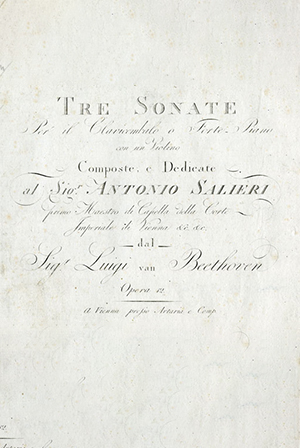
Three Sonatas for Harpsichord or Fortepiano and Violin, Opus 12, dedicated to Antonio Salieri. First edition published in Vienna by Artaria & Comp. in 1798 or 1799. Gift of Ira F. Brilliant, 1999
Beethoven briefly studied counterpoint with Albrechtsberger, from 1794-1795. Couterpoint is the art of writing one or more lines of music against an original line. Beethoven remained friendly and respectful of Albrechtsberger. After Albrechtsberger died (just two months before Haydn’s passing), Beethoven agreed to give music theory lessons to Albrechtsberger’s grandson. In 1821, a revised and enlarged edition of Albrechtsberger’s Grundliche Anweisung zur Composition was published. Beethoven recommended it to the budding composer Carl August Reichardt in 1825.
DID BEETHOVEN STUDY WITH MOZART?
According to reminiscences, Beethoven was taken on his 1787 visit to Mozart, who requested that the fortepianist play something for him. Mozart, assuming that what Beethoven had played was a carefully prepared show-piece, praised it in a somewhat cool manner. Beethoven, observing Mozart’s tone, begged Mozart for a theme on which to improvise, one of Beethoven’s greatest musical gifts. Beethoven improvised in such a style that Mozart, who paid more and more attention and interest as Beethoven proceeded, finally went to some friends in the adjoining room and excitedly exclaimed, “Keep your eyes on him. Some day he will give the world something to talk about.”
However, Beethoven himself was curiously silent about this experience. Most intriguing are the cryptic notes in Beethoven’s conversion books, written by his nephew Karl. “You knew Mozart?,” Karl asked. Beethoven’s verbal response is not recorded, but to that Karl replied, “Where did you see him?” Some scholars assumed that Beethoven’s encounter with Mozart must have been brief because he was called back to Bonn when his mother became seriously ill. However, new research by Dieter Haberl proves that Beethoven could have spent up to ten weeks in Vienna. Such a period of time would certainly have allowed time for him to play for and even have lessons with Mozart.
In Merle’s fanciful painting, Beethoven’s classic upward gaze as he plays the organ indicates his communication with the spirit of imagination and creation. Mozart has successfully quieted the members of the nobility present, who normally regarded music as only background accompaniment to their witty conversations.
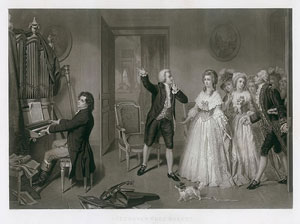
Engraving of “Beethoven chez Mozart” by Paul Allais from a painting by H. Merle; engraved by Alfred Chardon, Paris; published by Bulla frères, Paris, and L.T. Neumann, Vienna, 1858
THE PROGENY
BEETHOVEN AS TEACHER
The “Easy” Sonatas, Opus 49
Most of Beethoven’s sonatas for fortepiano are full of technical and musical challenges, but he did write some easier works intended for students. Among these works are his two so-called “easy” sonatas, which he probably composed mostly for his friends and students and not for wider circulation. However, his brother Carl took it upon himself to offer the sonatas to several publishers, first to Johann André in Offenbach in 1802 and then to the firm Breitkopf & Härtel in Leipzig 1803. Finally, in January 1805 the Viennese firm, the Bureau d’Arts et d’Industrie, published the two sonatas for sale to the public for 2 florins, a price roughly equivalent to the fee for a 2-hour fortepiano lesson. Since then, countless thousands of piano teachers have assigned these sonatas to their students.
(Purchased with contributions to the Manuscript Fund by Ira and Irma Brilliant, Jim Compton, Faith Davies, Bud Dodge, James Healey, Kathleen Hulburd, William D. Faulhaber (in memory of Charles Everett Brennand), Carol and Lin Krebs, Henry M. Neiger, and Thomas Wendel, 1994)
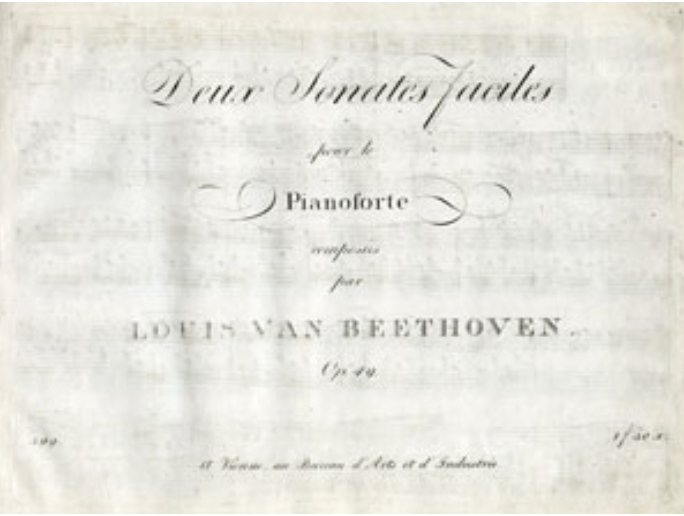
Two Easy Sonatas for the Pianoforte, Opus 49, composed by Beethoven in 1796-1798 First edition, published in Vienna by the Bureau d’Arts et d’Industrie, 1805
FERDINAND RIES AND ARCHDUKE RUDOLPH
Ferdinand Ries was the son of Franz Ries, Beethoven’s violin teacher in Bonn. Ferdinand was very young when Beethoven left Bonn but they became acquainted after Ferdinand moved to Vienna in the winter of 1801/1802. Beethoven immediately accepted him as a fortepiano student, giving him three 90 minute lessons every week! Ries progressed rapidly and made his public debut in 1804 playing Beethoven’s Third Fortepiano Concerto with his own cadenza. Ries became a successful composer and dedicated his first Fortepiano Sonatas, Opus 1, to Beethoven.
Another friend from Beethoven’s youth was Eleanor von Breuning (1771-1841), whom Beethoven met around 1782 when he was hired to give piano lessons to her and her brother Lorenz. Beethoven became very close to the entire family, spending many days and even nights at their home. Beethoven was quite fond of Eleanor and dedicated a few of his early compositions to her, including this relatively simple, two movement Sonata in C Major. Beethoven wrote to Eleanor from Vienna, promising to send the sonata to her, but explained that it was “practically only a sketch” so he would need to do the copying himself. After Beethoven’s death in 1827, the sonata was published for the first time based on Beethoven’s incomplete manuscript. Beethoven’s student Ferdinand Ries, by then a respected composer, added eleven measures to complete the work.
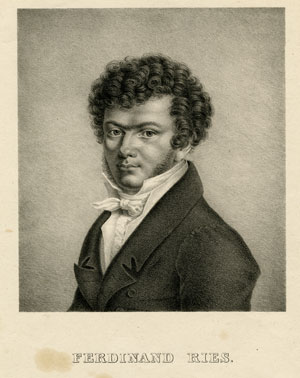
Ferdinand Ries (1784-1838). Portrait lithograph, ca. 1830 Gift of the American Beethoven Society, 2008
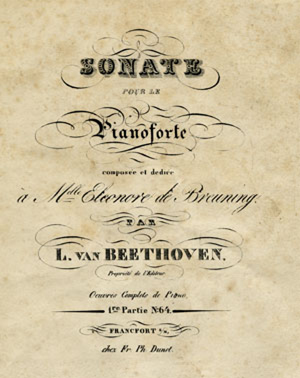
Fortepiano Sonata in C Major, WoO 51, composed by Beethoven in 1791-1792 and dedicated to Eleanor von Breuning. First edition, published by F.P. Dunst in Frankfurt am Main, ca. 1830. Gift of the American Beethoven Society, 1993
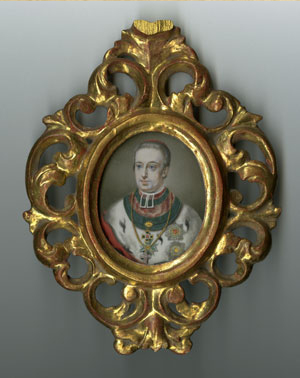
Archduke Rudolph (1788-1831)
Portrait miniature by Adalbert Suchy, oil on ivory,
Gift of the American Beethoven Society, 2006
Perhaps as early as 1803, Beethoven met the man who would become one of his most important patrons as well as a student. Rudolph was the youngest son of Emperor Leopold II and lived in the imperial palace in Vienna. He took minor vows in the Catholic Church, eventually becoming Archbishop and then Cardinal of Ölmutz, but his passion was music. By the time he began his studies with Beethoven, he was already performing as a fortepianist at private concerts at the Lichnowsky Palace. His playing improved under Beethoven’s guidance, and he premiered Beethoven’s Sonata for Violin and Fortepiano, Opus 96, with the violinist Pierre Rode. An observer at that concert wrote that “the performance as a whole was good, but we must mention that the piano part was played far better, more in accordance with the spirit of the piece, and with more feeling than that of the violin.” Although Rudolph was forced to reduce his playing activities due to arthritis and other physical problems with his hands, he did continue to practice when possible. Until about 1824, when he left Vienna for Olmütz, Rudolph received regular instruction from Beethoven in music theory and composition. He wrote several works for fortepiano, including Forty Variations on a Theme by Beethoven published in 1819.
BEETHOVEN’S FEMALE FORTEPIANO STUDENTS
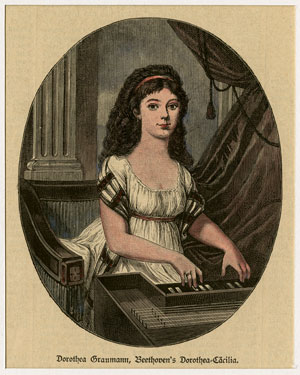
Dorothea Graumann married Baron Stephan Ertmann in 1798 and the couple settled in Vienna around 1803. Dorothea was already a skilled fortepianist when she met Beethoven at a music store where she was sight reading some of his sonatas. By that time she already owned copies of several of Beethoven’s published works and was one of his greatest admirers. Reports on her playing of Beethoven’s fortepiano music are full of superlatives for both her technical skill and sensitive interpretations. On hearing her playing, one musician referred to her as Beethoven’s “Dorothea Cäcilia,” calling up the patron saint of music. Her insights into these often difficult works were likely partly shaped by her lessons with Beethoven during her years in Vienna from 1803-1817.
Dorothea Ertmann (1781-1848) Woodcut engraving printed in the Allgemeine Illustrirte Zeitung, ca. 1879
Gift of the American Beethoven Society, 2010
In 1817, Dorothea Ertmann moved from Vienna to the nearby village of St. Pölten, where her husband’s army regiment was stationed. In her honor, Beethoven dedicated his Sonata in A Major, Opus 101 to her. The second movement of this Sonata has a march-like character (perhaps an association with Dorothea’s husband). The third movement, which is very expressive and extraordinary in its delicacy, is to be played with the una corda pedal held throughout. After recalling the main theme of the first movement, the third movement leads directly into a triumphal finale, where Beethoven weaves the theme into a fugal passage.
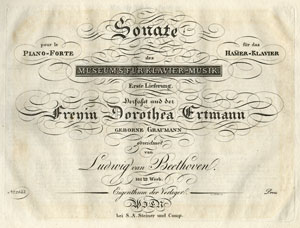
Fortepiano Sonata in A Major, Opus 101, dedicated to Dorothea Ertmann
First edition published in Vienna by S.A. Steiner & Co., 1817 Gift of Ira F. Brilliant, 1985
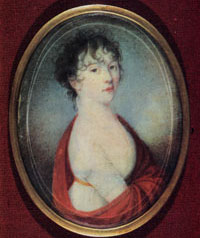
Julia Guicciardi
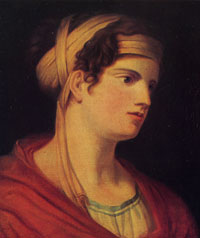
Therese von Brunsvik
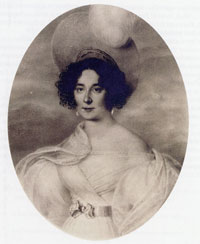
Therese Malfatti
Julia Guicciardi, Therese von Brunsvik, Therese Malfatti These three women were amateur pianists who took fortepiano lessons from Beethoven. Countess Julie Guicciardi was 15 or 16 and Beethoven nearly 30 when they first met. He described her as an “enchanting girl” and may have wished to marry her. When her mother sent him a purse with coins to pay for his teaching services, he was insulted by the reminder that he was not of their class and was regarded more as an employee than a friend. Beethoven dedicated his Sonata quasi una fantasia, Opus 27, no. 2 (known as the “Moonlight” Sonata) to Julia. The sketchleaf owned by the Beethoven Center (on display in the lower drawer of the center display case) was once in the possession of her family.
Therese von Brunsvik was the eldest of the Brunsvik siblings, Hungarian aristocrats who befriended Beethoven during their frequent trips to Vienna. In 1799 their mother asked Beethoven to give Therese and her sister Josephine fortepiano lessons during their two-week stay. He was so taken with the young ladies that he agreed to come to their hotel every day. He even wrote for them a set of variations for piano duet on a theme set to the first stanza of “Nähe des Geliebten,” (“Nearness of the Beloved One”), a beautiful love poem by Wolfgang von Goethe. Here is a translation of the entire poem:
I think of you when I see the sun’s shimmer gleaming from the sea.
I think of you when the moon’s glimmer is reflected in the springs.
I see you when on the distant road the dust rises,
In deep night, when on the narrow bridge the traveler trembles.
I hear you when with a dull roar the wave surges.
In the quiet grove I often go to listen when all is silent.
I am with you, however far away you may be,
You are next to me!
The sun is setting, soon the stars will shine upon me.
If only you were here!
The other Therese was the niece of Beethoven’s doctor Johann Malfatti. She met Beethoven in 1810 when their mutual friend Baron von Gleichenstein introduced him to her family. He greatly enjoyed their company, especially the beautiful Therese who was 18 at the time. He not only gave her lessons on the fortepiano but also loaned her manuscript copies of some of his unpublished works. One of these may have been the little piece now known as “Für Elise.” Some Beethoven scholars believe that Beethoven actually wrote this piece for Therese, whom he may have hoped to marry.
THE LEGACY
FOLLOWING THE PATHS OF BEETHOVEN’S STUDENTS
CARL CZERNY
Beethoven’s most famous pupil is perhaps best known today to piano students the world over as the composer of keyboard studies designed to develop advanced skills. By the time he was 10, Czerny had already made his public debut and could play many of the works of Mozart and Clementi from memory. Beethoven heard him play his own “Pathétique” Sonata and immediately offered to give him lessons. Carl later described these lessons in detail, recalling how Beethoven had him practice scales in all keys and exercises from the keyboard method book by C.P.E. Bach. Although the lessons did not continue regularly or for an extended period, Czerny became a lifelong friend and a champion of Beethoven’s music. Although much in demand as a teacher, he also agreed to give piano lessons to Beethoven’s nephew Karl (who had little of his uncle’s talent) in 1816-1818. He transcribed many of Beethoven’s orchestral works (including all nine of the symphonies) for fortepiano duet. His commentary on the interpretation of Beethoven’s piano sonatas, published in his Complete Theoretical and Practical Piano School in 1839, remains an invaluable resource.
Among Czerny’s numerous fortepiano compositions are several based on themes by Beethoven. For these three short rondos, Czerny used themes from Beethoven’s song, “Das Glück der Freundschaft” (“The Happiness of Friendship”), Opus 88.
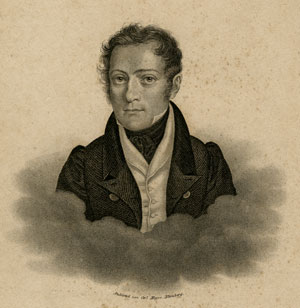
Carl Czerny (1791-1857)
Portrait engraving by Carl Mayer published by Schubert & Niemeyer in Hamburg and Itzehoe, a. 1830
Gift of the American Beethoven Society, 2004
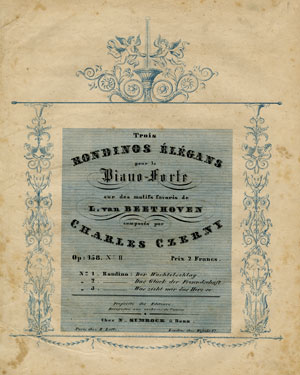
Carl Czerny, Three Elegant Rondinos for the Pianoforte on Favorite Motives of L. van Beethoven
Published in Bonn by N. Simrock, ca. 1838. Gift of the American Beethoven Society, 2009
FRANZ LISZT
Czerny transmitted his knowledge and appreciation of Beethoven’s music to his pupil Franz Liszt, who studied fortepiano with him after the family moved to Vienna in 1822, when Liszt was 10. Czerny took his pupil to meet Beethoven, and the “little Liszt” wrote in Beethoven’s conversation book inviting him to attend his concert on April 13, 1823. Many years later, Liszt recounted that after the concert Beethoven praised his excellent performance by bestowing a “consecration kiss.” Scholars still argue about whether the story is true. However, there is no doubt that Liszt held a special reverence for Beethoven’s music and was a major influence in making it better known to nineteenth-century audiences. His edition of Beethoven’s sonatas was first published in 1857, and he transcribed all of Beethoven’s symphonies and several other works for solo fortepiano. Among his many philanthropic activities was his very generous financial support and fund-raising for the Beethoven monuments in Bonn (erected in 1845) and Vienna (erected in 1880). This year we celebrate the 200th anniversary of Liszt’s birth.
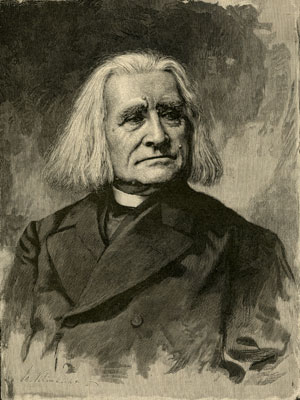
Franz Liszt (1811-1886) Woodcut engraving, ca. 1880 Gift of the American Beethoven Society, 2006
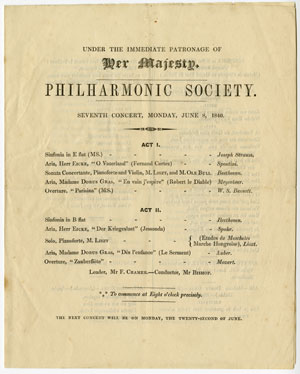
Original concert program for the Philharmonic Society, London, June 8, 1840 Gift of the American Beethoven Society, 2004This program included a performance by Franz Liszt and the violinist Ole Bull (1810-1880) of Beethoven’s “Kreutzer” Sonata, Opus 47. Also on the program was Beethoven’s Symphony in B-Flat Major, Opus 60.
ALFRED JAELL
This concert featured the first performance in St. Louis of Beethoven’s Symphony no. 2, Opus 36. Featured on the program was the Austrian pianist Alfred Jaell (1832-1882), a pupil of Czerny. Jaell’s very successful extended tour of the U.S. lasted from 1851-1854. The presenters of this concert found it necessary to admonish the audience to arrive on time, “it being very annoying to the performers, and to those who enjoy Beethoven’s masterwork, to be disturbed by late arrivals.” As a chamber musician, Jaell frequently appeared with the violinists Ole Bull (1810-1880) and Henryk Wieniawski (1835-1880), whose performances of Beethoven’s “Kreutzer” Sonata were highly praised.
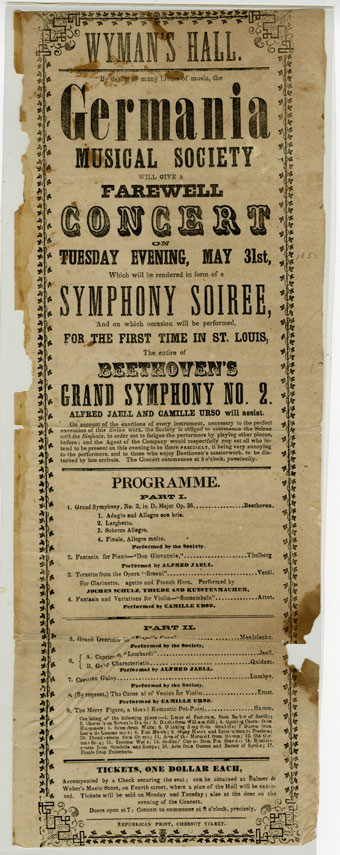
Original handbill for the Germania Musical Society concert in St. Louis, Missouri, May 31, 1853 Gift of the American Beethoven Society, 2005
HANS VON BÜLOW
The prominent German conductor, pianist, teacher, and composer Hans von Bülow was also the first husband of Franz Liszt’s daughter Cosima, who left him for Richard Wagner. Bülow’s career as a conductor was already well underway when he turned to Liszt for retraining in piano, which as a child he had studied with Friedrich Wieck, Clara Schumann’s father. Under Liszt’s guidance, he followed a strict practicing regimen and earned his teacher’s praise as a talent that would place him “in the first rank of the greatest pianists.” He did extensive touring beginning in 1872, including 139 concerts in the United States in 1875-1876. In his 50s he demonstrated his stamina by performing all five of Beethoven’s late sonatas in a single concert. In 1872, his editions of many of Beethoven’s piano works appeared as volumes 4-5 of the Instructive Edition of Classical Piano Music, with a dedication to Liszt.
The music quoted in this autographed document is from the last movement of Beethoven’s “Appassionata” Sonata, Opus 57, with fingerings added using the English system.
In this letter, Bülow writes in the musical motto “Muss es sein?” (“Must it be”]) that Beethoven used for his String Quartet, Opus 135, here in the context of planning the repertory for an upcoming concert.
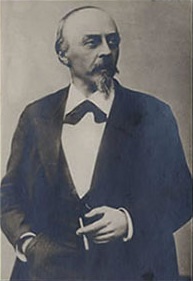
Hans von Bülow (1830-1894) Photograph with autograph musical inscription dated Nov. 28, 1873 Gift of the American Beethoven Society, 1998
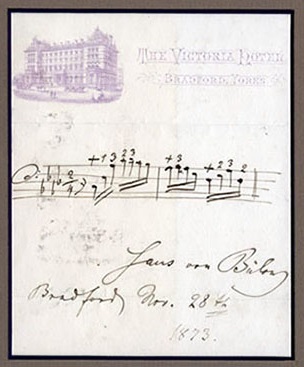
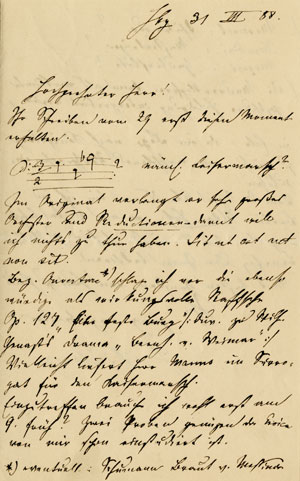
Signed autograph letter from Hans von Bülow to an unidentified recipient in Heidelberg
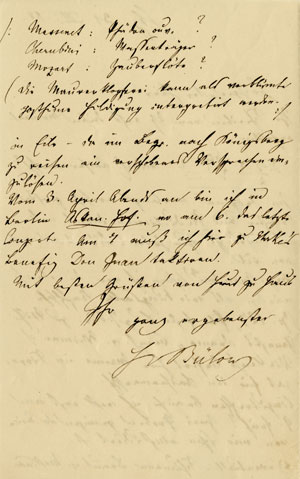
dated March 31, 1888
Gift of the American Beethoven Society, 2005
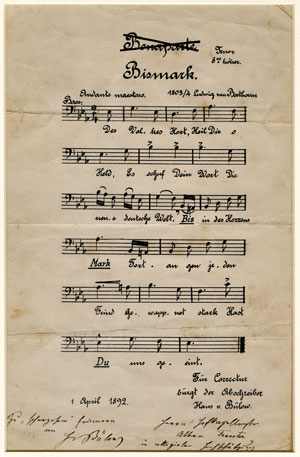
“Bismark,” a rededication of Beethoven’s Eroica Symphony by Hans von Bülow Gift of the American Beethoven Society, 2008
This score, printed in 1892, combines a text on Otto Bismark (1815-1898) with a theme from Beethoven’s Third Symphony that was originally titled the Bonaparte Symphony. As prime minister of Prussia beginning in 1862, Bismark was largely responsible for the unification of the Prussian states. He became the first Chancellor of Germany in 1871 but was removed from power by Kaiser Wilhelm II in 1890. Bülow caused a scandal when, at the conclusion of his final concert as artistic director for the Berlin Philharmonic on March 28, 1892, he announced that he was consecrating Beethoven’s symphony “to the greatest spiritual hero to have the seen the light of the world since Beethoven … to Beethoven’s brother, to the Beethoven of German politics, to Prince Bismarck!” The last two lines of text of the rededication, which incorporates a play on Bismark’s name, can be roughly translated as “Bismarck in You we trust, You united us!” This copy owned by the Beethoven Center includes the signatures and inscriptions of Bülow and the violinist Alban.
EUGEN D’ALBERT
The pianist Eugen d’Albert was still a teenager when he was sent to Vienna in 1881 to meet Liszt, who accepted him as a student. They worked together in Weimar, and Liszt came to consider d’Albert as one of his most outstanding pupils. However, d’Albert had less affinity for the programmatic music that was then in vogue (including the music of Liszt) than for the German masters. He became a leading interpreter of Beethoven’s music. In 1961, the American pianist Andor Foldes published this reminiscence of hearing d’Albert in concert:
“I will never forget Eugen d’Albert, that great titan of the piano, whose solo and orchestral concerts were the delight of my childhood and the never-to-be-topped ideal of my youth. Especially do I cherish one particular matinée he gave about 1924 in Budapest’s largest theatre, the Varosi Szinhaz, seating some 2,200 people. It started with the Emperor, after which the interval enabled the audience to catch its breath, and provided occasion at the same time to clear the stage of desks and chairs, so that in the second half the Master occupied the entire tremendous platform himself, playing various solo works of Beethoven, including the Appassionata and the Rage over a Lost Penny in a grandiose, royal manner which still rings in my ears. The beginning of the Emperor finale was – or so it seemed to me at the time – a unique miracle of ferociousness and dare-devilry. It was, I felt, the epitome of heroism, the last word in what a human being was able to do in recapturing the untamed spirit of one Ludwig van Beethoven – long gone from our midst, yet triumphantly alive thanks to such an interpreter as d’Albert.”
The handwritten inscription on display underneath the photograph reads “Auf Ihre ges. Anfrage jedenfalls: Beethoven” (“To answer your question, of course: Beethoven”).
In this letter d’Albert mentions his upcoming performances of Beethoven’s Piano Sonata in E-flat Major, Opus 31, no. 3 and the “Waldstein” Sonata, Opus 53.
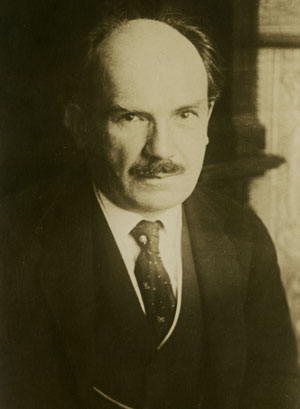
Eugen d’Albert (1864-1932) Postcard photograph with handwritten note about Beethoven; Gift of the American Beethoven Society, 2010
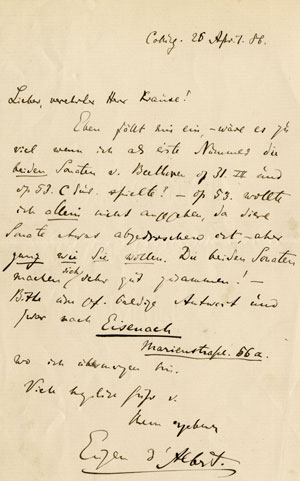
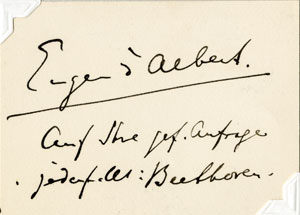
Autograph letter from Eugen d’Albert to Herr Kraus, Coburg, April 26, 1886
Gift of the American Beethoven Society, 2010 [m2b030]
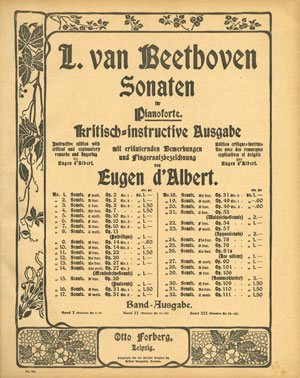
First Edition of Eugen d’Albert’s “Critical-Instructive Edition” of Beethoven’s Fortepiano Sonatas, published in Leipzig by Otto Forberg, 1902
Gift of the American Beethoven Society, 2009
WILHELM BACKHAUS
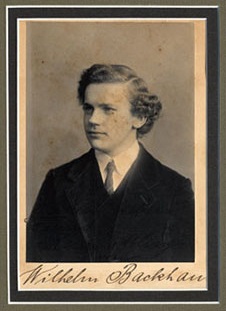
lhelm Backhaus (1884-1969), a student of d’Albert
Photograph with autograph musical inscription to Henry Effling in Manchester, dated Feb. 27, 1902
Gift of the American Beethoven Society, 1998
After studies at the Leipzig Conservatory, a young German pianist named Wilhelm Backhaus went to Frankfurt am Main in 1898 for private lessons with Eugen d’Albert. Although at that time d’Albert refused to take pupils, the precocious Backhaus “forced the door open. “How did I dare to do it?,” he later pondered during an interview. “D’Albert didn’t even give lessons, his time was very precious and he was determined not to waste it! By a miracle, however, I found favor in his eyes. At any rate he didn’t begrudge me his attention for in that year (1898) he let me play to him more than twenty-five times!” Backhaus returned to London two years later to embark on a solo concert career, and in 1902 performed Beethoven’s Fourth Concerto with the Hallé Orchestra conducted by Hans Richter after the scheduled pianist fell ill. The music he quotes in this autograph is from the slow movement the Fourth Concerto, under which Backhaus added the caption “Orpheus in the Underworld.” It was d’Albert’s teacher Franz Liszt who first attached the description of Orpheus taming the Furies in Hades with his lyre to the second movement of Beethoven’s concerto.
Backhaus was one of the earliest concert pianists to make recordings. In the early 20th century, technology for recording on phonograph records was still in its infancy. However, at the end of the nineteenth century several piano makers had developed piano roll technology to reproduce performances on a pianola, or player piano. The piano roll consists of a roll of paper with punched holes. Each hole represents the position and length of the note played on a piano. As the role moves over a tracker bar in a player piano, the note sounds. As early as 1904, the Welte-Mignon firm in Germany began using this technology to record famous pianists/composers such as Claude Debussy and Richard Strauss. The following year, the rival company of Ludwig Hupfeld in Leipzig began producing his own series of Künsterlermusikrollen (Artist’s Music Rolls) that could be played on his Phonola pianos. The website of the Pianola Institute describes the recording process:
Pianists visited the Hupfeld studios in central Leipzig, in similar fashion to those who were recording for the Welte-Mignon, at the Popper salon a few streets away. Although the resulting hand-played rolls were immediately available for the Phonola, with printed dynamic markings for the player to follow, they were also designed with Hupfeld’s recent Phonoliszt in mind, an expression piano powered by an electric suction pump, with three levels of automatic dynamics, and variable speed crescendos between the levels. The grand piano used for recording was linked pneumatically to the machine that marked the master rolls, and an additional five tubes allowed for limited dynamic information to be recorded in real time. It is not yet clear whether there were separate sets of dynamic tubes for the treble and bass, since the Phonola had a divided mechanism, whereas the Phonoliszt did not.
Backhaus contributed to Hupfeld’s catalog by recording works by Grieg. However, this performance of Beethoven’s Hammerklavier, which could be played using Hupfeld’s patented “Soladant” system, appears to be unknown in the discography of Backhaus’s recordings. The paper of this piano roll contains the “Phonola” watermark and the date 1911. In the 1950’s, when long-playing records were being produced, Backhaus recorded all of the Beethoven piano sonatas for the London label. His project to re-record the sonatas in the 1960’s was unfortunately unfinished at the time of his death.
After Backhaus won the Anton Rubinstein competition in 1905, his touring took him frequently to North and South America. This program was for one of eight concerts in Buenos Aires featuring the complete cycle of Beethoven’s 32 piano sonatas and other works. The program contains a slight misprint: the Sonata no. 25 is Opus 79, not Opus 69 as printed here. By the 1950s Backhaus was regarded as a Beethoven interpreter with few rivals, and his series of Beethoven recitals at Carnegie Hall received wide acclaim.
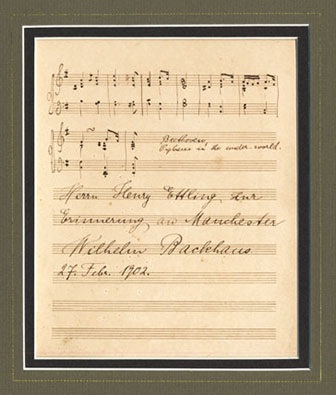



Signed autograph note from Wilhelm Backhaus to Lotte Kluge, with a musical quotation, dated June 17, 1941
Gift of the American Beethoven Society, 2010

In this autograph, Backhaus transcribes the opening of Beethoven’s Fifth Fortepiano Concerto.
ARTUR SCHNABEL
Dorothea Graumann married Baron Stephan Ertmann in 1798 and the couple settled in Vienna around 1803. Dorothea was already a skilled fortepianist when she met Beethoven at a music store where she was sight reading some of his sonatas. By that time she already owned copies of several of Beethoven’s published works and was one of his greatest admirers. Reports on her playing of Beethoven’s fortepiano music are full of superlatives for both her technical skill and sensitive interpretations. On hearing her playing, one musician referred to her as Beethoven’s “Dorothea Cäcilia,” calling up the patron saint of music. Her insights into these often difficult works were likely partly shaped by her lessons with Beethoven during her years in Vienna from 1803-1817.
Dorothea Ertmann (1781-1848) Woodcut engraving printed in the Allgemeine Illustrirte Zeitung, ca. 1879
Gift of the American Beethoven Society, 2010
In 1817, Dorothea Ertmann moved from Vienna to the nearby village of St. Pölten, where her husband’s army regiment was stationed. In her honor, Beethoven dedicated his Sonata in A Major, Opus 101 to her. The second movement of this Sonata has a march-like character (perhaps an association with Dorothea’s husband). The third movement, which is very expressive and extraordinary in its delicacy, is to be played with the una corda pedal held throughout. After recalling the main theme of the first movement, the third movement leads directly into a triumphal finale, where Beethoven weaves the theme into a fugal passage.
Artur Schnabel studied piano in Vienna with the great Polish pianist Theodor Leschetizky (1830-1915), one of Czerny’s students, and began his concert career at the age of 8. However, his years in Berlin from about 1919-1924 were the most formative in his development as a musician. During this period, in addition to exploring contemporary music and composing his own works, he was also developing his own personal style in the interpretation of Beethoven. In 1927, for the 100th anniversary of Beethoven’s death, Schnabel performed a complete cycle of Beethoven’s 32 sonatas, repeating this series in 1932 and then in London in 1934. His free approach lacked the technical polish of some other pianists (such as Backhaus), but his interpretations have been described as imaginative and visionary, “still faithful to the composer’s intention, to the spirit rather than the letter.” Leschetizky described his student not as a pianist but as a musician, one who transcended the boundaries of his instrument (an assessment that Beethoven himself would likely relate to). In 1939 he and his wife fled Nazi Germany to the United States, and he became an American citizen in 1944. Schnabel’s famous editions of the Beethoven sonatas first appeared in installments in 1924-1927 and have been reprinted many times as a tw0-volume set. The pianist Claude Frank, who studied with Schnabel, described this edition as “an inspiring, detailed and eloquent description of Schnabel’s conception.”
In 1932 Schnabel contracted with His Master’s Voice to record all of the Beethoven sonatas, the first pianist to undertake such a project. Shortly afterward he also recorded all five of Beethoven’s concertos. For this 78 rpm recording, five discs were required to capture the entire Fifth Concerto.
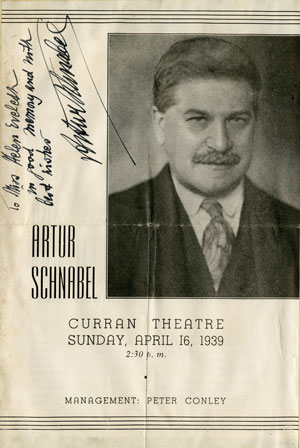
Artur Schnabel (1882-1951), student of Leschetizky, a student of Czerny
Autographed program for an all-Beethoven concert at the Curran Theater, San Francisco, April 16, 1939
Gift of the American Beethoven Society, 2008
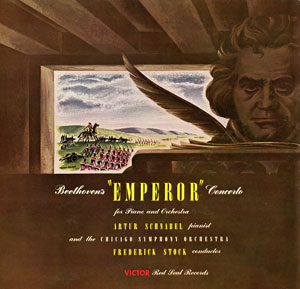
Recording by Artur Schnabel of Beethoven’s Fortepiano Concerto no. 5, Opus 73, on the Victor “Red Seal” Label, 1943